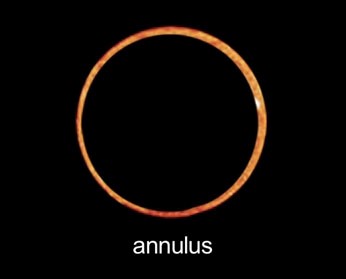When the Moon covers the Sun
February 24, 2017
By Amy Sayle
A solar eclipse—when the Moon covers the Sun—happens this weekend. On Sunday, February 26, 2017, an annular solar eclipse will be visible from a narrow path in the southern hemisphere. A partial solar eclipse will be observable from a much larger area, but not from North America.
The reason we can have solar eclipses is that the Moon and Sun appear roughly the same size in the sky. But during some eclipses, like the one this weekend, the Moon is a bit too far from Earth to completely cover the Sun. This leaves a ring, or annulus, of sunlight around the dark silhouette of the Moon. (Note: It’s important to observe a solar eclipse safely, such as by using special “eclipse glasses.”)
Although most of you reading this blog will miss this weekend’s solar eclipse, be sure to mark your calendar for the next one, on August 21, 2017. On that day, the United States gets a partial eclipse. But the eclipse will be total for those in a narrow path stretching across the continent from Oregon to South Carolina.

Credit: NASA JPL “What’s Up for May 2012”
This path of totality clips a small portion of the southwest corner of North Carolina. Depending on where in North Carolina you live, you may actually find it easier to visit South Carolina for the total eclipse.
For Chapel Hill, and the Triangle area in general, the Sun will become only partially eclipsed – 93% covered at around 2:40 p.m. on Monday, August 21. That may sound like a lot, but 93% eclipsed will not be 93% of the experience.
In May 2012, I observed an annular eclipse from Bryce Canyon National Park, where 87% of the Sun’s disk was covered by the Moon. Although some people reported they detected a change in the quality of the light around them, I couldn’t tell the difference. My memory is of bright daylight the entire time.
If you want to see it go dark in the daytime, watch planets and bright stars become visible, and observe the Sun’s corona, then you’ll want to study an eclipse map and make plans now to go to the path of totality on Monday, August 21, 2017.

